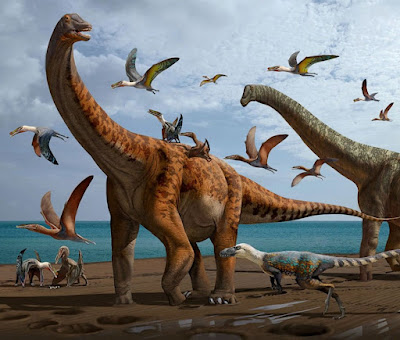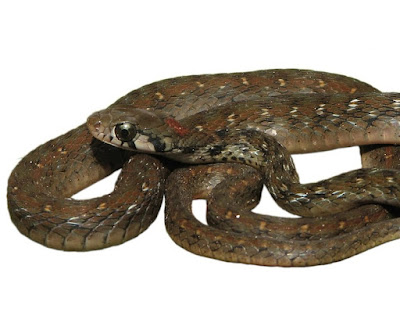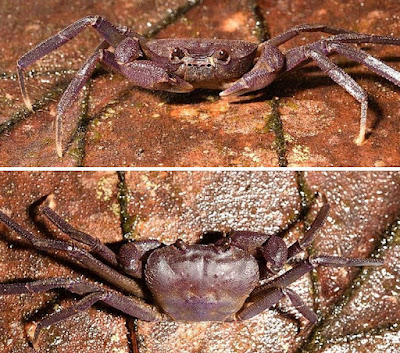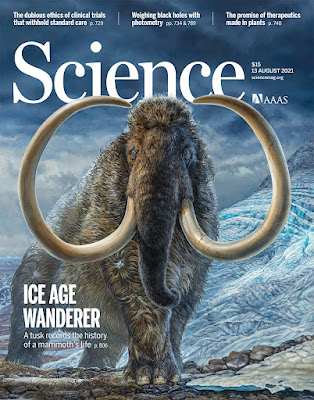[Most Recent Entries] [Calendar View]
Friday, August 13th, 2021
| Time | Event | ||||
| 6:08a | [Paleontology • 2021] Silutitan sinensis & Hamititan xinjiangensis • The First Dinosaurs from the Early Cretaceous Hami Pterosaur Fauna, China
Abstract The Early Cretaceous Hami Pterosaur Fauna in Northwest China preserves a large number of specimens of the sexually dimorphic pteranodontoid pterosaur Hamipterus tianshanensis, including 3D eggs and embryos. During the last decade, several more fossils have been collected in this area, including three somphospondylan sauropod specimens. The first is Silutitan sinensis gen. et sp. nov., which consists of an articulated middle to posterior cervical vertebrae series. The second, Hamititan xinjiangensis gen. et sp. nov., consists of an incomplete articulated caudal sequence that could be assigned to lithostrotian titanosaurs based on the strongly procoelous caudal vertebrae with lateral concave surface, as well as marked ventrolateral ridges. The third specimen consists of four sacral vertebral elements, apparently unfused, with exposed camellate internal bone and regarded as somphospondylan. Cladistic analyses based on different datasets recovered Silutitan sinensis as an euhelopodid closely related to Euhelopus and Hamititan xinjiangensis as a titanosaur. Besides the pterosaur Hamipterus and one theropod tooth, these dinosaurs are the first vertebrates reported in this region, increasing the diversity of the fauna as well as the information on Chinese sauropods, further supporting a widespread diversification of somphospondylans during the Early Cretaceous of Asia.
Systematic paleontology SAUROPODA Marsh, 1878 NEOSAUROPODA Bonaparte, 1986 TITANOSAURIFORMES Salgado et al., 1997 SOMPHOSPONDYLI Wilson & Sereno, 1998 EUHELOPODIDAE Romer, 1956 (sensu D’Emic, 2012) Silutitan gen. nov. Type species. Silutitan sinensis sp. nov., type by monotypy. Etymology. “Silu” means the “Silk Road” in Chinese Mandarin pinyin, in memory the great trade routes which connected the East and West. “titan” means giant in Greek, symbolic of the large size of this genus. Silutitan sinensis new species. Etymology. "sinensis" refers to China, in Latin. Holotype. An articulated series of six cervical vertebrae (IVPP V27874) with almost all cervical ribs, housed at IVPP (Figs. 2, 3; Table 1). Locality and Horizon. Hami, Xinjiang, China; Lower Cretaceous Shengjinkou Formation (Tugulu Group). Diagnosis. An euhelopodid sauropod exhibiting the following autapomorphies found in the cervical vertebrae: (1) ventrolaterally bifurcated postzygodiapophyseal laminae [PODL] in middle to posterior cervical vertebrae, (2) anteriorly bifurcated posterior centrodiapophyseal laminae [PCDL] on the four posterior-most cervical vertebrae, (3) parapodiapophyseal laminae [PPDL] forming developed ventral flanges, (4) contact surface of diapophysis and tuberculum in the middle and posterior cervical vertebrae constricted on anterior and posterior faces. It is further characterized by the following combination of characters: cervical vertebrae with developed epipophyses, prezygodiapophyseal laminae anteriorly projected, lateral pneumatic fossae on centra restricted anteriorly, neural arches with two fossae bordered by the epipophyseal-prezygapophyseal laminae, and the neural spines reduced anteroposteriorly. SOMPHOSPONDYLI Wilson & Sereno, 1998 TITANOSAURIA Bonaparte & Coria, 1993 Hamititan gen. nov. Type species. Hamititan xinjiangensis sp. nov., type by monotypy. Etymology. “Hami” refers to Hami city where the specimen was found, “titan”, from the giants of the Greek myths and commonly used to name titanosaur taxa. Hamititan xinjiangensis new species. Etymology. “xinjiangensis”, refers to Xinjiang, China. Holotype. An articulated series of seven anterior to middle caudal (HM V22), including the proximal portions of three chevrons, housed at Hami Museum (Figs. 2, 4; Table 2). Locality and Horizon. Hami, Xinjiang, China; Lower Cretaceous Shengjinkou Formation (Tugulu Group). Diagnosis. A titanosaur sauropod exhibiting the following autapomorphies: (1) tall neural arches with the neural arch higher than the height of the centrum, (2) neural arch on the anteriormost caudal sagittally expanded, (3) deep postzygapophyseal spinodiapophyseal fossa [POSDF] presenting inner open cavities on the anteriormost caudal vertebrae, (4) transverse processes on most anterior caudal vertebrae directed upwards, (5) abruptly change of orientation of the transverse processes from upward (see 3) to downwards. The new species is further characterized by the following combination of characters: prezygapophyses on the caudal vertebrae projecting mainly anterodorsally; and short transverse processes compressed anteroposteriorly and directed laterally. Conclusions: The discovery of Silutitan sinensis and Hamititan xinjiangensis increased the sauropod diversity of Asia, particularly from an area where these vertebrates are not common. Silutitan sinensis is closely related to Euhelopus. The existence of a more inclusive clade of similar sauropods (Euhelopodidae) is still a matter of debate and pends on more detailed description of some putative euhelopodid. Hamititan xinjiangensis is one of the few titanosaurian sauropod recovered from Asia, which shows an unusual combination of sauropod features. The presence of two somphospondylan species in the Tugulu Group novel information on somphospondylan evolution and provides further support for a widespread diversification of these sauropods during the Early Cretaceous of Asia. Xiaolin Wang, Kamila L. N. Bandeira, Rui Qiu, Shunxing Jiang, Xin Cheng, Yingxia Ma and Alexander W. A. Kellner. 2021. The First Dinosaurs from the Early Cretaceous Hami Pterosaur Fauna, China. Scientific Reports. 11, 14962. DOI: 10.1038/s41598-021-94273-7 Xiaolin Wang, Alexander W.A. Kellner, Shunxing Jiang, ... et Zhonghe Zhou. 2014. Sexually Dimorphic Tridimensionally Preserved Pterosaurs and Their Eggs from China. Current Biology. DOI: 10.1016/j.cub.2014.04.054 | ||||
| 7:09a | [Herpetology • 2021] Rhabdophis bindi • Hidden in the Plain Sight: A New Species of Rhabdophis (Serpentes: Colubridae: Natricinae) from the Rhabdophis himalayanus complex
Abstract A new species of natricine snake of the genus Rhabdophis is described from Northeast India. Morphologically the new species is similar to Rhabdophis himalayanus but it can be distinguished from it by lacking a nuchal groove and nuchal glands, being relatively smaller, and having a distinct neck, ventral, and subcaudal coloration. In overall coloration it resembles R. chrysargos, from which it is distinguished by several aspects of its morphology and genetic differences. The discovery of Rhabdophis bindi sp. nov. reveals that forested regions in the northeastern part of India needs further biological exploration. Keywords: Reptilia, Biodiversity Hotspot, cryptic, Northeast India, nuchal gland, Rhabdophis sp. nov., systematics, taxonomy, rare
Rhabdophis bindi sp. nov. Abhijit Das, Eric N. Smith, Irvan Sidik, Goutam C. Sarker, Bitupan Boruah, Naitik G. Patel, B.H.C.K Murthy and V. Deepak. 2021. Hidden in the Plain Sight: A New Species of Rhabdophis (Serpentes: Natricinae) from the Rhabdophis himalayanus complex. Zootaxa. 5020(3); 401-433. DOI: 10.11646/zootaxa.5020.3.1 | ||||
| 9:46a | [Crustacea • 2021] Arachnothelphusa rimba & A. bako • On Two New Species of Arboreal Crabs (Brachyura: Gecarcinucidae) from Phytotelms in Sarawak, Borneo
Abstract Two new species of the gecarcinucid freshwater crab genus Arachnothelphusa are described from the Malaysian state of Sarawak in Borneo; one from Lanjak-Entimau Wildlife Sanctuary and another from Bako National Park. Arachnothelphusa rimba n. sp. is distinctive in possessing very long legs and a male first gonopod which has a cylindrical proximal part of the terminal segment, with the distal part sharply tapering to an acute tip. Arachnothelphusa bako n. sp. is superficially closest to A. kadamaiana from Sabah, but differs markedly by its narrower epistome, and proportionately shorter third maxillipeds and ambulatory legs. Keywords: Crustacea, Tree crab, taxonomy, Gecarcinucoidea, semiterrestrial freshwater crab, East Malaysia, Southeast Asia, new species Peter K. L. Ng. 2021. On Two New Species of Arboreal Crabs from Phytotelms in Sarawak, Borneo (Crustacea: Brachyura: Gecarcinucidae: Arachnothelphusa). Zootaxa. 5016(3); 407-418. DOI: 10.11646/zootaxa.5016.3.6 | ||||
| 10:09a | [PaleoMammalogy • 2020] Lifetime Mobility of An Arctic Woolly Mammoth Mammuthus primigenius A mammoth's life: Fossils have long given us glimpses of the life that came before us, but these glimpses are generally static. They tell us a bit about species that lived, but not much about how they lived. Evolving techniques are deepening our viewpoint. Wooller et al. examined isotopes collected from the tusk of a 17,000-year-old mammoth to elucidate its movements from birth to death. This included its time—likely with a herd—as an infant and juvenile, then as a prime-age adult, and then as a declining senior over its approximately 28-year life span. Abstract Little is known about woolly mammoth (Mammuthus primigenius) mobility and range. Here we use high temporal resolution sequential analyses of strontium isotope ratios along an entire 1.7-meter-long tusk to reconstruct the movements of an Arctic woolly mammoth that lived 17,100 years ago, during the last ice age. We use an isotope-guided random walk approach to compare the tusk’s strontium and oxygen isotope profiles to isotopic maps. Our modeling reveals patterns of movement across a geographically extensive range during the animal’s ~28-year life span that varied with life stages. Maintenance of this level of mobility by megafaunal species such as mammoth would have been increasingly difficult as the ice age ended and the environment changed at high latitudes. Matthew J. Wooller, Clement Bataille, Patrick Druckenmiller, Gregory M. Erickson, Pamela Groves, Norma Haubenstock, Timothy Howe, Johanna Irrgeher, Daniel Mann, Katherine Moon, Ben A. Potter, Thomas Prohaska, Jeffrey Rasic, Joshua Reuther, Beth Shapiro, Karen J. Spaleta and Amy D. Willis. 2021. Lifetime Mobility of An Arctic Woolly Mammoth. Science. 373, 6556; 806-808. DOI: 10.1126/science.abg1134 |
| << Previous Day |
2021/08/13 [Calendar] |
Next Day >> |




















